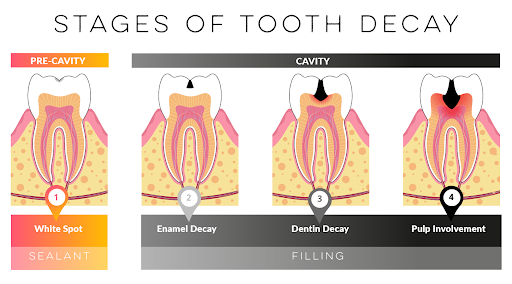Dental sealants are usually used to prevent cavities. But sometimes they can be used to seal up minor cavities as well. Whether sealants are right for your kid depends on many things.
For example, one child’s back teeth might be smooth. Another’s could be full of nooks and crannies. Also, a small cavity might be sealable for one child, but the same size cavity in another child might need to be filled. Ultimately, knowing how and why sealants are used will help parents make the right decision for their child.
Why Dental Sealants?
Dental sealants (sometimes called pit and fissure sealants) are used to protect against cavities in the molars and premolars of permanent teeth as soon as they come in. They prevent cavities to avoid needing fillings.
The most cavity-prone years are ages 6 to 14. This is when permanent teeth push baby teeth out. It’s also when parents have less control of their child’s diet and tooth care. Dental sealants prevent the most cavities when applied soon after permanent molars come in. This is about age 6 for first molars, and age 12 for second molars.
According to the Centers for Disease Control, “once applied, dental sealants protect against 80% of cavities for 2 years and continue to protect against 50% of cavities for up to 4 years.” The same report says: “children 6 to 11-years of age without sealants have almost three times more first molar cavities than children with sealants.”
Those are pretty striking statistics, especially when you think about the pain and expense of dental fillings over time. Dental sealants can be applied to baby teeth and permanent teeth.

Signs That Dental Sealants Are Needed
Dental sealants will benefit you the most if they are applied before cavities occur. Dental Sealants are usually called for in cases with:
- Narrow grooves and fissures on newly erupted permanent back teeth (molars)
- Staining in the grooves and fissures
- Decay in one of the first permanent molars
- Special needs children
- Extensive decay in baby teeth
Dental sealants might not be necessary if you can stop decay from occurring through proper tooth brushing, diet, and fluoride. So think: What are your child’s eating habits? Does he or she have deep grooves in their teeth, with lots of nooks and crannies? How well does your child brush? How much guidance are you prepared to provide about good oral care?
What About Baby Teeth?
Because baby teeth will fall out anyway when permanent teeth come in at about age 6-14 (upper and lower molars come in at different times) many parents question if dental sealants are worth worrying about.
The decision to have dental sealants applied to baby teeth depends most on how likely the child is to develop cavities. Children who eat a lot of sugary foods and have extensive nooks and crannies in their back teeth are candidates for dental sealants.
Protecting baby teeth from cavities is just as important as protecting permanent teeth. They are placeholders for permanent teeth. Cavities in baby teeth can cause permanent teeth to come in crooked or misaligned.
Dental Sealants And Existing Cavities
The goal of a sealant is to prevent exposure to food, saliva, and other cavity-causing things. That said, research from the American Association of Pediatric Dentistry has shown that sealants can sometimes stop existing decay, too. It’s harder for decay causing bacteria (caries) to live and cause more tooth decay under a sealant…but only if the sealant is applied perfectly. The process requires precision and a highly skilled technician—especially where there are signs of existing decay.
The American Dental Association also reports that dental sealants can be used to treat early signs of tooth decay before a cavity forms. If your dentist notices an area likely to form a cavity (seen as white spots) sealants can be used to stop further decay. But, if decay has extended past level 1 (pre-cavity), the cavity should be filled.

Dental Sealant Risks
It’s not a matter of putting the dental sealant on and your child is done. Molars and premolars must be perfectly dry, or the sealant won’t adhere. Fissures that run deep are harder to seal. If the child is fidgety in the dentist’s chair, saliva can get in, causing the sealant to fail or wear out. That’s actually one of the leading causes of sealant failure.
The deeper the fissures, the greater the risk of bacteria leaking underneath and causing decay. Some fissures in a tooth might be too deep to clean out with the dentist’s tools.
Tooth grinding, or eating ice and hard candy, can do damage to sealants—which is why frequent check ups are important. If dental sealants fail, it can happen as quickly as the first six months.
Types of Dental Sealants
There are two main types of dental sealants for children: Resin-Based Sealants and Glass Ionomer Sealants. Resin-Based Sealants adhere longer. But the area needs to be really dry when they are applied. Glass Ionomer Sealants contain fluoride, which can help to prevent (and sometimes reverse) decay. These sealants are usually replaced with resin-based sealants when the child gets older. Other types of sealants are Polyacid-Modified Resin Sealants and Resin-Modified GI sealants.
The Ultimate Guide: Your Child’s Dentist
Dental sealants must be monitored frequently (at least two times per year). This can easily be done during your child’s checkup.
If your dentist is recommending sealants, ask about:
- The material used
- Whether fillings are appropriate
- Diagnostic tools to ensure decay is not being sealed in
- How often they will need to be replaced
- Frequency of follow up
If you don’t have a dentist or are looking for a different one, try using our Make An Appointment tool.


